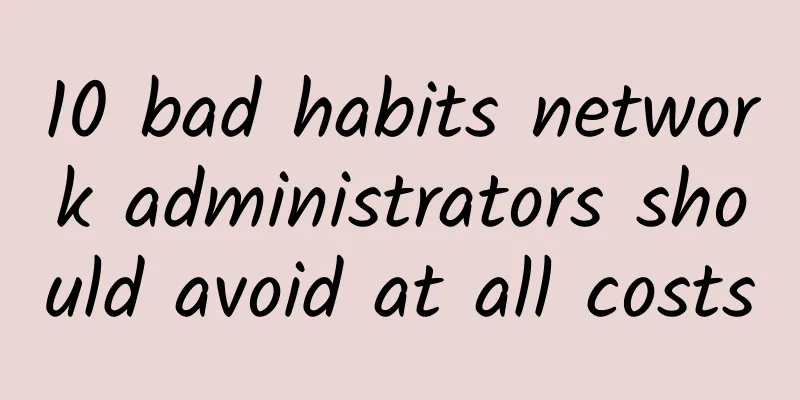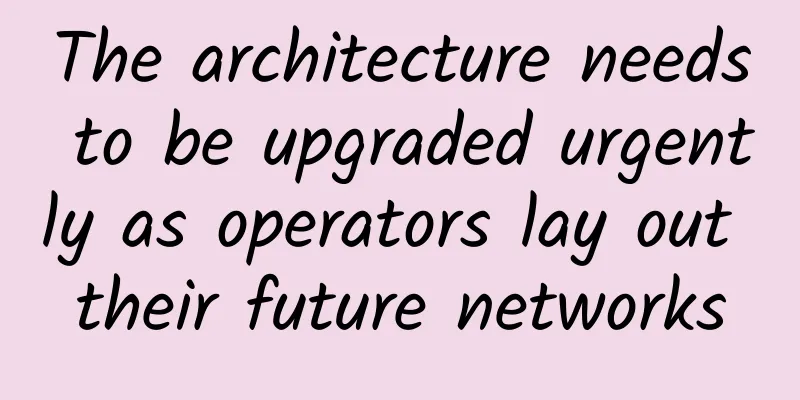10 bad habits network administrators should avoid at all costs

|
Every enterprise network consists of devices that transmit and store information and faces an ever-growing number of sophisticated cyber threats. Network administrators play a critical role in preventing unauthorized access, data loss, malware, and security breaches by implementing end-to-end controls. However, there are several common mistakes along the way that can expose your company to unnecessary risk. Here are 10 bad habits that network administrators need to avoid in order to improve their work efficiency.
1. Failure to regularly update strategies Kyle Gingrich, vice president of IT and certification at Skillsoft, said that policy is the living and breathing element of the network and needs to be revisited regularly to account for changes in monitoring and managing the network internally and externally. He added: "The network is a combination of multiple third-party devices and applications, so changes made by network administrators will also affect the policies of these components." 2. Do everything manually Brad M. Shaw, president and CTO of Dallas Web Design, says that when you automate processes, you can get rid of mundane routines, increase efficiency, and gain more control over your overall IT infrastructure. In addition, “from a security perspective, you no longer have to work with unstructured, manual processes, and automation makes it easier to audit and analyze activity patterns,” Shaw says. 3. Making changes but not recording them during the change control process “It’s easy to say I’m going to change this configuration,” said Jim Frey, vice president of strategic alliances at Kentik and a former network industry analyst. “But days or weeks later, when someone wants to know why something broke, they need to understand what changed from the expected baseline. That’s why it’s so important to have a change control process.” 4. Believe that your network security is impenetrable According to Lindsey Havens, senior marketing manager at PhishLabs, overconfidence in network security can lead to ignoring hacker attacks or other security threats. Ignoring the security of the entire network environment is another similar mistake, Havens said: "Sometimes network administrators are so nervous and worried about threats and networks that they don't examine the effectiveness of the entire security system." Public cloud infrastructure and cloud-based network services continue to create blind spots for network administrators, said Moshe Elias, director of product marketing at Allot Communications. “Network visibility is invaluable when it comes to security because it exposes IT security vulnerabilities before they become a problem, reducing risk to data,” said Elias. “From shadow IT to the IoT security landscape, and the evolving security challenges of public cloud and network virtualization, network visibility tools will continue to evolve in the future.” Failure to protect network access can also be a major pitfall, Gingrich said. "Hackers shouldn't be able to gain access to critical keys through a single access point or data storage location."
5. You are experiencing alert fatigue and short-term thinking Alert fatigue is a term used to describe the phenomenon where network administrators and other security analysts become unable to respond to security alerts because they are bombarded with the same type of data too many times a day. "Too many alerts create a sense of overload for IT staff," said Christopher Ensey, COO of Dunbar Security Solutions. "In the security space, we are seeing an explosion of new tools and an exponential growth in the number of notifications. Network administrators need to have better ways to filter, prioritize and correlate events." According to Greg Hoffer, president of engineering at Globalscape, because network administrators have become accustomed to putting out fires, their default attitude becomes one of short-term decision making to solve problems rather than enabling technologies and processes that support business transformation or foster innovation. “Putting out fires is important, but when it becomes a habit for network administrators, they miss an opportunity to contribute to the success of the business,” Hoffer said. “In my experience, when IT teams have a deep understanding of the company’s mission and their role in achieving shared goals, they have more empathy for each department’s tasks and individual challenges, which leads to better collaboration and an appropriate sense of urgency, encouraging IT to take an active role in implementing and achieving the organization’s vision.” 6. Failure to continuously update skills Peter Tsai, senior technology analyst at Spiceworks, said: As the technology industry continues to change, if IT professionals are not constantly learning, their skills will become increasingly outdated. "If they are complacent in their work without exploring new ideas, methods or technologies, they will risk limiting their future career development. Even if there is a lack of practical training in emerging technologies, IT personnel can survive in the competition by gaining more knowledge and experience through training courses, obtaining certifications or setting up home labs." Gingrich said that cyber strategies and threats are constantly changing, and staying up to date is key to protecting your network. 7. Use the command line interface to troubleshoot network problems Justin Ryburn, technical marketing manager at Kentik and a former network engineer, said network administrators need to log into the command-line interface (CLI) of network equipment and manually troubleshoot network performance issues. "Instead, they should build tools that leverage internal and external APIs and databases to get the performance alerts and information they need," Ryburn said. 8. Allow ports and protocols to connect to the Internet outbound According to IT consultant Ben Piper, allowing ports and protocols to be accessible on the Internet is a bad idea. "Only allow the standard tcp/80 for http, tcp/443 for https, and others you know are required by the enterprise; block all other interfaces." Also, some malware uses SSH (tcp/22), so network administrators should only allow access to each IP address that has a destination, Piper said.
9. Use scripts in automated networks “As IT operations rapidly modernize, one bad habit network administrators need to break is the misguided use of scripts in automated networks,” said Cortney Thompson, CIO at Green House Data. “While scripting can significantly reduce the burden of network management, it must be done within a framework rather than applying a hodgepodge of packages or trying to continually bridge the gaps of legacy code.” Thompson said the DevOps model can provide a more efficient and scalable direction for network automation, "in a way that takes into account tooling, code channels, immutable infrastructure, upgrades and restore capabilities," and applying the DevOps model to the network can help realize the benefits of DevNetOps, which enables continuous integration and deployment. 10. Poor monitoring guidelines Patrick Hubbard, principal consultant at SolarWinds, said that as networks grow in size, complexity and geographic distribution, poor monitoring discipline becomes an easy habit to develop. The growth of the cloud also makes it difficult to determine the root cause of performance issues. And network administrators rarely conduct cross-monitoring with server administrators, storage administrators and other managers. “Cross-cut monitoring provides a holistic view across the enterprise IT landscape, so eliminating legacy monitoring methods can make root cause analysis more efficient and accurate, reducing costs in the process,” Hubbard said. “In order for network administrators to be effective, they need to expand their current knowledge and skills to effectively monitor hardware, networks, applications, virtualization, configurations, clouds and even container workloads.” |
<<: Small functions of wireless routers make your Wi-Fi more useful
>>: What is missing for blockchain to be used commercially on a large scale?
Recommend
RackNerd limited time promotion for 72 hours, annual payment starts from $14.89 in Los Angeles data center
Today, RackNerd offers three hot-selling packages...
Game software crashes and reports errors every day? A magic tool that solves the problem with one click
[[349399]] Many friends have encountered the prob...
It turns out that there are so many tricks in O2O search! Meituan Xian Yunsen reveals how to make services smarter
[51CTO.com original article] The Global Software ...
5G is changing society, but is millimeter wave still missing?
Three years ago, 5G ushered in the first year of ...
Changchun Municipal Government Signs Strategic Cooperation Agreement with Huawei Cloud Computing Data Center
On the afternoon of March 31, the Changchun Munic...
The 5G license has been issued, what should we do now?
The 5G license really came a bit suddenly. People...
"Weibu Online" was successfully selected into the list of the third batch of specialized and innovative "little giant" enterprises announced by the Ministry of Industry and Information Technology
On July 19, in the third batch of specialized, so...
What will the communications network look like in 2030?
[[426987]] This article is reprinted from the WeC...
DMIT's new San Jose data center starts at $36.9/year, 15% off + free data
DMIT.io opened a new data center in San Jose, USA...
HostKvm newly launched China Unicom CUVIP line VPS, 1G memory package starts at $5.2/month after 20% discount
Recently, more and more merchants have connected ...
Mellanox Launches Innovative ConnectX-6 Dx Chip, BlueField-2 Secure Cloud SmartNIC and I/O Processing Unit Solutions
Beijing, China – September 3, 2019 – Mellanox Tec...
Operators’ 5G half-year exam: With the difficult epidemic, high expenditures and low profits, how can they withstand the pressure in the second half of the year?
The sudden outbreak of the novel coronavirus pneu...
In the 5G era, what is the way out for the three major operators that are crying poor?
As 2017 was coming to an end, news about 5G becam...
Uncover the hidden secrets of free WiFi!
Every time when you go out for shopping or playin...









